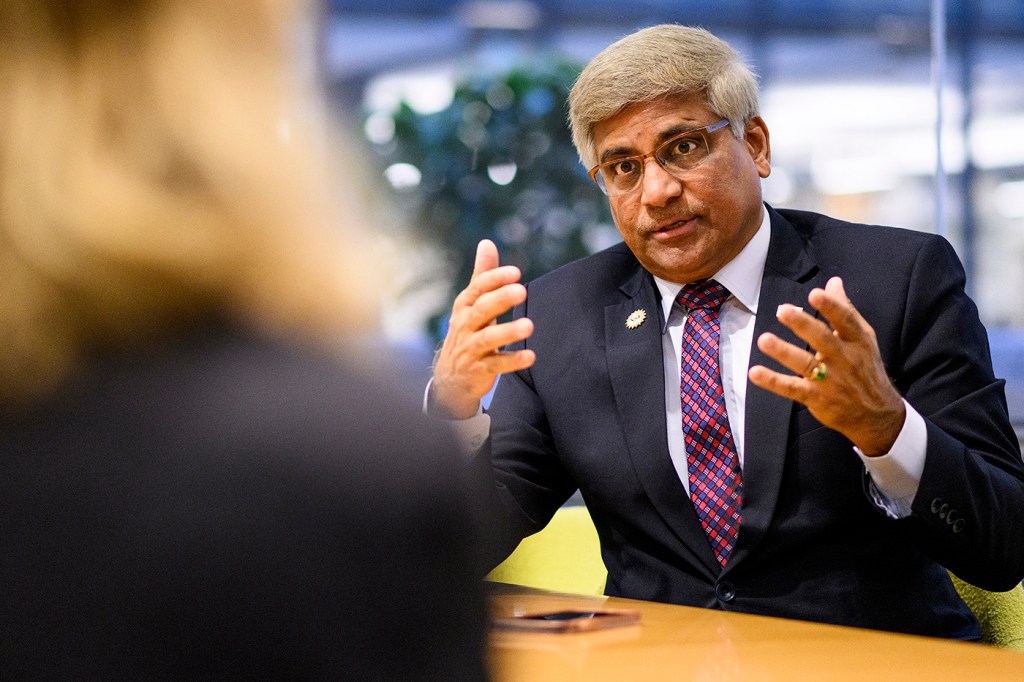‘Science is global!’ Q&A with National Science Foundation director Sethuraman Panchanathan

Sethuraman Panchanathan, the 15th director of the National Science Foundation spoke at the official opening of Northeastern’s EXP research center on Oct. 16.
A computer scientist and engineer, Panchanathan is known for championing innovation and inclusivity, and leading AI breakthroughs.
He sat down with Northeastern Global News for a wide-ranging conversation about what the NSF is doing to support impactful research solutions to pressing global and societal challenges —from infectious disease outbreaks to climate change and national security.
His responses have been edited for brevity and clarity.
Earlier this month the 2023 Nobel prizes in physiology/medicine, physics, chemistry and economics were announced. Tell us what the NFS has done to support future and current laureates.
As of right now, the NSF has funded 262 Nobel laureates early in their careers — the largest of any agency in the United States or anywhere in the universe.
The NSF unleashes talent all across our nation. It was founded in 1950, post-World War II, to answer the questions: How can we ensure human health, prosperity, welfare, national security and economic security for our nation?
It currently is a $10 billion agency unleashing ideas and promoting curiosity-driven, discovery-based research at scale.
The NSF has an imprint in all 50 states and territories and addresses all aspects of science, technology, engineering and innovation.
How does the NSF partner with academia and industry to foster innovation?
Let me give you something very native to Boston as an example — Ginkgo Bioworks. The NSF helped fund the company through grants including Small Business Innovation Research, or SBIR, grants.
Today it is a $6 billion company. What I’m trying to communicate here is that NSF makes possible basic research, fundamental research, translational research and impactful outcomes, including startup companies and people going into research.
If you were to go out to any technology company in Boston and ask them, “What do you think about NSF?” chances are you will run into people saying, “I was supported by an NSF undergraduate research fellow grant” or “My mentor had an NSF grant and they supported me from that.”
They would have been touched by the NSF in one way or another.
Experiential learning drives everything we do at Northeastern, including our research enterprise. What are your thoughts on integrating the real-world experience with what happens in labs?
Northeastern is the third-largest institution NSF invests in in Massachusetts — Woods Hole, MIT and Northeastern.
Whether it is pandemic prediction, climate change, climate mitigation, adaptation and resilience or any grand challenge issues that we have, you will find that NSF has made possible fundamental discoveries and translational discoveries that are coming to address the problem and provide solutions.
The real work happens in great places like Northeastern University.
When you have an experiential kind of a program, students get to see not only what the great academic researchers do in security and things of that nature, but they also get inspired by industry folks who do amazing work.
That’s what makes great innovations possible and great innovators possible. It’s like a feeding frenzy of ideas.
I would argue that without that mentor-mentee relationship, these ideas don’t flow at speed and scale. I was inspired by my mentor. And that made it possible for me to come up with some great ideas as part of my academic experience as a student.
You are a champion of using technological innovation to empower people with disabilities. Tell us why it is a priority.
My own work started off, as you said, with individuals with disabilities. I worked with individuals who are blind or visually impaired, people with motor impairments, cognitive impairments or children with autism.
But I soon realized that they were individuals with great ideas, great abilities. I have started using the term, “people with a range of abilities.” These are not people who don’t have abilities — they have abilities of a different type.
What you need to do is to see how technology, working with the individuals, can co-create amazing futures and amazing, great innovations.
What happens is when you start off thinking, “I’m going to assist individuals with visual disabilities to be able to have more gainful employment or purposeful lives,” the innovations become useful to the entire population.
Assistive note taking and remote communications are some examples. I’m not sure whether you know the typewriter was invented for the blind. Where is the typewriter right now? It’s here, in your cell phone.
How beneficial is it for researchers to have access to a global network? How does it encourage innovation?
I keep repeating this: Science is global!
Global expertise, global partnerships, global context are exceedingly important if you truly want to solve global grand challenges, plain and simple.
But in doing so, you want to work with like-minded global partners because at the end of the day, scientists are about core values. So one has to embrace those core values of openness, transparency, reciprocity, research, integrity and respect for intellectual property.
Then we can hyper partner so that we can solve these grand challenge problems much more comprehensively and faster.
What are some of the most important ingredients of creativity and innovation?
Freedom is the first fundamental step. If you’re a free spirit, you’re going to go out and innovate, right? You have no fear.
Fear is the worst form of curbing innovation. Or some kind of constraint, some kind of feeling that, “I know I cannot do this,” because that precludes your inevitable potential to express in its fullest form.
Fear is not a good motivator.
What is the NSF’s role in supporting research that doesn’t fall into one scientific silo?
Social, behavioral, economic sciences, the humanities and art are exceedingly important in the context of development and design of science and technology.
Climate change is not just a science problem or an engineering problem. We all know it’s a social problem. It’s a behavioral problem.
So unless we bring all inspirations to bear even in the conceptualization of the technology, and the design of development of the solutions, then we are trying to do patch work after the fact.
A trustworthy AI program that we partnered with Amazon, for example, does not just involve computing information and sciences, it involves the social behavioral economic sciences.
That’s the kind of mindset that we’re using to bring people to co-create programs. So the community out there can then start to respond by creating even grander ideas.
You are optimistic about the promise of AI and machine learning. Why should researchers embrace these technologies?
We have challenges in AI. Absolutely. But the promise of innovation, the potential of innovation, is way beyond what the challenges can do to slow down the innovation.
The challenges should motivate us, inspire us, to see what kinds of guardrails, what kinds of new technologies, what kind of innovations can be developed to address them.
We don’t walk away from challenges. We don’t shy away from challenges. We understand them, we configure them.
This is the time I would say to speed up rather than slow down.
Cynthia McCormick Hibbert is a Northeastern Global News reporter. Email her at c.hibbert@northeastern.edu or contact her on Twitter @HibbertCynthia.






